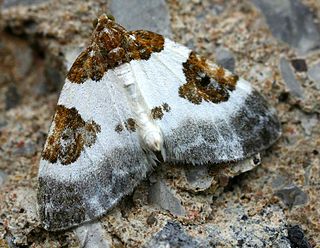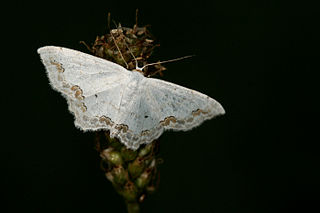
The geometer moths are moths belonging to the family Geometridae of the insect order Lepidoptera, the moths and butterflies. Their scientific name derives from the Ancient Greek geo γεω, and metron μέτρον "measure" in reference to the way their larvae, or inchworms, appear to measure the earth as they move\ along in a looping fashion. Geometridae is a very large family, containing around 23,000 described species; over 1400 species from six subfamilies are indigenous to North America alone. A well-known member is the peppered moth, Biston betularia, which has been the subject of numerous studies in population genetics. Several other geometer moths are notorious pests.

The Cidariini are the largest tribe of geometer moths in the subfamily Larentiinae. The Cidariini include many of the species known as "carpets" or, ambiguously, "carpet moths", and are among the few geometer moths that have been subject to fairly comprehensive cladistic study of their phylogeny. The tribe was described by Philogène Auguste Joseph Duponchel in 1845.

Scopula decorata, the middle lace border, is a moth of the family Geometridae. It is found throughout Europe.

Scopula immorata, the Lewes wave, is a moth of the family Geometridae. It is found throughout Europe and the Near East.

Lipomelia is a monotypic moth genus in the family Geometridae. It contains only one species, Lipomelia subusta, which is found in India and Taiwan. Both the genus and species were first described by William Warren in 1893.

Scopula ternata, the smoky wave, is a moth of the family Geometridae. It was described by Franz von Paula Schrank in 1802. It is mainly found in northern and parts of central Europe and in isolated populations in southern and south-eastern Europe. Its western range is eastern France, eastern Belgium and Scotland, with an isolated population in the Pyrenees. In the north its range extends to the polar regions and in the south it is found up to the Alps. Its eastern range extends through central and northern Russia up to the Ural, through Siberia up to the Yenisei River.

Sterrhinae is a large subfamily of geometer moths with some 3,000 described species, with more than half belonging to the taxonomically difficult, very diverse genera, Idaea and Scopula. This subfamily was described by Edward Meyrick in 1892. They are the most diverse in the tropics with the number of species decreasing with increasing latitude and elevation.

Scopulini is a tribe of the geometer moth family (Geometridae), with about 900 species in seven genera. The tribe was described by Philogène Auguste Joseph Duponchel in 1845.

Scopula ornata, the lace border, is a moth of the family Geometridae. The species was first described by Giovanni Antonio Scopoli in his 1763 Entomologia Carniolica. It is found in Europe, North Africa and the Near East.

Scopula limboundata, the large lace-border, is a moth of the family Geometridae. It was described by Adrian Hardy Haworth in 1809. It is found in North America east of the Rocky Mountains. There is a single and unconfirmed record from Great Britain.

Scopula incanata is a species of moth in the family Geometridae. It is found from north-eastern Europe and the Caucasus to southern Siberia and northern Mongolia.
Louis Beethoven Prout (1864–1943) was an English entomologist and musicologist.

Scopula minorata is a moth of the family Geometridae. It was described by Jean Baptiste Boisduval in 1833. It is found in Africa south of the Sahara, the Arabian Peninsula and on the islands of the Indian Ocean. Furthermore, it is found in southern Europe. It can be distinguished from Scopula lactaria only by examination of its genitalia.

Scopula emutaria, the rosy wave, is a species of moth in the family Geometridae. It is found in western and south-western Europe and Romania. Also in North Africa.
Scopula accentuata is a moth of the family Geometridae. It is found in the Democratic Republic of Congo, Kenya and South Africa.
Scopula achroa, the Tasmanian saltmarsh looper moth, is a moth of the family Geometridae. It was described by Oswald Bertram Lower in 1902. It is only found in the saltmarshes of Tasmania.

Scopula subpunctaria is a species of moth in the family Geometridae. It is found from northern and north-eastern China to the southern Palearctic realm.

Scopula beckeraria is a moth of the family Geometridae. It was described by Julius Lederer in 1853. It is found in Italy, Croatia, North Macedonia, Greece, Bulgaria, Romania, Ukraine, Russia, Turkey, Armenia, Israel, Lebanon, Iran, Turkmenistan and Kazakhstan.

Scopula caesaria is a moth of the family Geometridae. It has a wide range, including the Comoros, Mayotte, La Réunion, Madagascar and in Mauritius, Nigeria, South Africa, Tanzania, Gambia, Oman, the United Arab Emirates, New Guinea, Taiwan, Japan and Australia (Queensland).
William Warren was an English entomologist who specialised in Lepidoptera.















